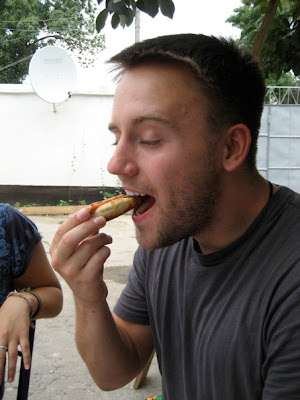Before I fell asleep last night I realized I had yet to extensively broach the topic of Tajik food. I've mentioned the deliciousness of osh and showed some pictures of the absurd smorgasborg that was my birthday, but here and now I'm going to delve a little deeper. Get ready to get hungry...
 |
| From DW in Dushanbe |
What makes Tajik food so great is its simplicity and ripeness: it is consistently the freshest food I've ever eaten. Pesticides and preservatives are not used here, therefore the food is brimming with flavor when properly refrigerated or preserved. But should one happen upon food not thoroughly kept one should expect to take the next few days off. Eating anything here is a roll of the dice--at home or at a restaurant. Nor does eating the same food as someone else guarantee safety; it's a dish to dish matter. The odds are generally in ones favor but know that at one point or another every traveler to Tajikistan gets sick; it's praticaly inevitable but easily cured with some anti-parasitic or anti-biotics. So when you come, be sure to bring some proper pills.
Getting back to the important things: Osh, also called plov, is the dish of Tajikistan. They cook it for birthdays, weddings, guests, and on any and every other celebration. As I mentioned a while back, Osh is made with a few basic ingredients: meat (usually lamb), rice, chopped carrots, sunflower seed oil (and lots of it), onions, and spices (it sometimes also includes chickpeas and cilantro). After much pre-cooking preparation, this delicious meat-rice stew is cooked for an hour-and-a-half in a large wok-like brass bowl over a fire; then it is ravenously devoured with one's hands, a spoon, or bread (my go-to). It's a personal favorite of mine.
 |
| From DW in Dushanbe |
 |
| From DW in Dushanbe |
The best way to start any meal in Tajikistan is eating salat-e shikarob, which is similar to salad-e Shirazi or Israeli salad. It is made with finely chopping tomatoes, onions, and some cucumbers and throwing them together in a bowl. Personally I like to chop up and add qalomfurs (really spicey peppers) into the mix. Shikarob is the most common appeitzer here and is--like everything else--eaten with bread.
 |
| From DW in Dushanbe |
Noun. or bread, is essential to Tajik cuisine so much so it is considered sacred. At home I am given warm circular loaves of bread with each meal; they're really good. Go to lunch at any Tajik restaurant and you'll get the same. One of my favorite parts of Tajikistan is that there are lots of ways to eat your food: hands, spoon (the sppon is the go to utensil here), or bread. You can scoop anything from osh to shikarob to soup.
 |
| From DW in Dushanbe |
Finally: soup. There are countless types of soups in Tajikistan. My favorites include laq-mon (a noodle, vegetable and meat soup pictured below, whose name derives from the word "lo mein") and shurbo (a tomato-based, meat soup). The others usually contain a chicken- or tomato-base, cooked with vegatables (lots of potatoes), and meat. Soups are staples of the Tajik lunch menu, and like everything else, are refreshing and delicious.
 |
| From DW in Dushanbe |
Writing a book on the broad and enticing Tajik cuisine is not enough; there are so many more dishes like sambusas (little kanish-like pastries filled with onion and either meat, squash, or almost anything else), shashlik (kebabs), qourutob (a giant loaf of bread cooked in yogurt, topped with deliciously carmalized onions), dried furits, nuts,and so many more. And like noun, to help digestion, tea is part of every Tajik meal--black, green, etc.
 |
| From DW in Dushanbe |
The Tajik people are very serious about their food. If your invited to a Tajik home prepare to eat lots because guests must eat--lots. And even after your full get ready to be commdanded "Gir!" ("take!") or "Khor!" ("eat!"). Food is an irreplacable element in the Tajik culture and my favorite part of Tajikistan. If you'd like to read a little more here is a link to the "Tajik Cuisine" wikipedia article.
P.S. Surprisingly ketchup is really, really good here.



























